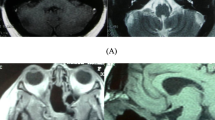Abstract
Endoscopic endonasal approaches (EEAs) are ideal for most chordomas, but there is little information regarding the practical clinical classification of clival chordomas to guide surgery with EEAs. This article investigates a relatively concise and practical clinical classification system for clival chordomas and summarizes the clinical characteristics and operative key points of different clinical types. Here, 55 patients with clival chordomas treated through EEAs from 2012 to 2017 were retrospectively reviewed. Depending on the origin of the notochord and the growth pattern of the tumor, with our introduced Wang’s line, these cases of clival chordoma were divided into types I–IV. There were 14 cases of type I-A, 7 cases of type I-B, 10 cases of type II, 10 cases of type III-A, 7 cases of type III-B, and 7 cases of type IV. The gross total resection (GTR) rate of primary and recurrent type I tumors was 64% and 25%, and residual tumors were found mainly in cases with involvement of the cavernous sinus or the posterior upper part of the dorsum sella. The GTR rate of primary and recurrent type II tumors was 85% and 66.6%, respectively. Residual tumors were found in cases with involvement of the petrous apex. The GTR rate of primary and recurrent type III tumors was 75% and 20%, and residual tumors were found in cases with involvement of the parapharyngeal space and dorsal side of C1–2. Residual type I-B and type III-B tumors were found when there was BA or VA adhesion or brain stem invasion. Our new classification method proposed here can be used to guide the resection of clival chordomas through EEAs.







Similar content being viewed by others
References
Koutourousiou M, Snyderman CH, Fernandez-Miranda J, Gardner PA (2011) Skull base chordomas. Otolaryngol Clin N Am 44:1155–1171. https://doi.org/10.1016/j.otc.2011.06.002
Walcott BP, Nahed BV, Mohyeldin A, Coumans JV, Kahle KT, Ferreira MJ (2012) Chordoma: current concepts, management, and future directions. Lancet Oncol 13:e69–e76. https://doi.org/10.1016/S1470-2045(11)70337-0
Kassam A, Snyderman CH, Mintz A, Gardner P, Carrau RL (2005) Expanded endonasal approach: the rostrocaudal axis. Part I. Crista galli to the sella turcica. Neurosurg Focus 19:E3
Kassam A, Snyderman CH, Mintz A, Gardner P, Carrau RL (2005) Expanded endonasal approach: the rostrocaudal axis. Part II. Posterior clinoids to the foramen magnum. Neurosurg Focus 19:E4
Kassam AB, Gardner PA, Snyderman CH, Carrau RL, Mintz AH, Prevedello DM (2008) Expanded endonasal approach, a fully endoscopic transnasal approach for the resection of midline suprasellar craniopharyngiomas: a new classification based on the infundibulum. J Neurosurg 108:715–728. https://doi.org/10.3171/JNS/2008/108/4/0715
Koutourousiou M, Gardner PA, Tormenti MJ, Henry SL, Stefko ST, Kassam AB, Fernandez-Miranda JC, Snyderman CH (2012) Endoscopic endonasal approach for resection of cranial base chordomas: outcomes and learning curve. Neurosurgery 71:614–625. https://doi.org/10.1227/NEU.0b013e31825ea3e0
Mangussi-Gomes J, Beer-Furlan A, Balsalobre L, Vellutini EA, Stamm AC (2016) Endoscopic endonasal management of skull base chordomas: surgical technique, nuances, and pitfalls. Otolaryngol Clin North Am 49:167–182. https://doi.org/10.1016/j.otc.2015.09.011
Al-Mefty O, Borba LA (1997) Skull base chordomas: a management challenge. J Neurosurg 86:182–189. https://doi.org/10.3171/jns.1997.86.2.0182
Kamrin RP, Potanos JN, Pool JL (1964) An evaluation of the diagnosis and treatment of chordoma. J Neurol Neurosurg Psychiatry 27:157–165
Gui S, Zong X, Wang X, Li C, Zhao P, Cao L, Zhang Y (2016) Classification and surgical approaches for transnasal endoscopic skull base chordoma resection: a 6-year experience with 161 cases. Neurosurg Rev 39:321–333. https://doi.org/10.1007/s10143-015-0696-1
Zoli M, Milanese L, Bonfatti R, Faustini-Fustini M, Marucci G, Tallini G, Zenesini C, Sturiale C, Frank G, Pasquini E, Mazzatenta D (2018) Clival chordomas: considerations after 16 years of endoscopic endonasal surgery. J Neurosurg 128:329–338. https://doi.org/10.3171/2016.11.JNS162082
Smoll NR, Gautschi OP, Radovanovic I, Schaller K, Weber DC (2013) Incidence and relative survival of chordomas: the standardized mortality ratio and the impact of chordomas on a population. Cancer 119:2029–2037. https://doi.org/10.1002/cncr.28032
George B, Bresson D, Herman P, Froelich S (2015) Chordomas: a review. Neurosurg Clin N Am 26:437–452. https://doi.org/10.1016/j.nec.2015.03.012
Di Maio S, Temkin N, Ramanathan D, Sekhar LN (2011) Current comprehensive management of cranial base chordomas: 10-year meta-analysis of observational studies. J Neurosurg 115:1094–1105. https://doi.org/10.3171/2011.7.JNS11355
McMaster ML, Goldstein AM, Bromley CM, Ishibe N, Parry DM (2001) Chordoma: incidence and survival patterns in the United States, 1973-1995. Cancer Causes Control 12:1–11
Wu Z, Zhang J, Zhang L, Jia G, Tang J, Wang L, Wang Z (2010) Prognostic factors for long-term outcome of patients with surgical resection of skull base chordomas-106 cases review in one institution. Neurosurg Rev 33:451–456. https://doi.org/10.1007/s10143-010-0273-6
Stippler M, Gardner PA, Snyderman CH, Carrau RL, Prevedello DM, Kassam AB (2009) Endoscopic endonasal approach for clival chordomas. Neurosurgery 64:268–278. https://doi.org/10.1227/01.NEU.0000338071.01241.E2
Sen C, Triana AI, Berglind N, Godbold J, Shrivastava RK (2010) Clival chordomas: clinical management, results, and complications in 71 patients. J Neurosurg 113:1059–1071. https://doi.org/10.3171/2009.9.JNS08596
Thodou E, Kontogeorgos G, Scheithauer BW, Lekka I, Tzanis S, Mariatos P, Laws ER Jr (2000) Intrasellar chordomas mimicking pituitary adenoma. J Neurosurg 92:976–982. https://doi.org/10.3171/jns.2000.92.6.0976
Author information
Authors and Affiliations
Corresponding author
Ethics declarations
Conflict of interest
The authors declare that they have no conflicts of interest.
Ethical approval
Approval of the retrospective study was obtained from the research ethics committee of the First Affiliated Hospital of China Medical University.
Informed consent
For this type of study, formal consent is not required.
Additional information
Publisher’s note
Springer Nature remains neutral with regard to jurisdictional claims in published maps and institutional affiliations.
Note: The paper has not been presented previously.
Rights and permissions
About this article
Cite this article
Wang, Q., Wang, Y., Wang, J. et al. Clinical classification of clival chordomas for transnasal approaches. Neurosurg Rev 43, 1201–1210 (2020). https://doi.org/10.1007/s10143-019-01153-w
Received:
Revised:
Accepted:
Published:
Issue Date:
DOI: https://doi.org/10.1007/s10143-019-01153-w




